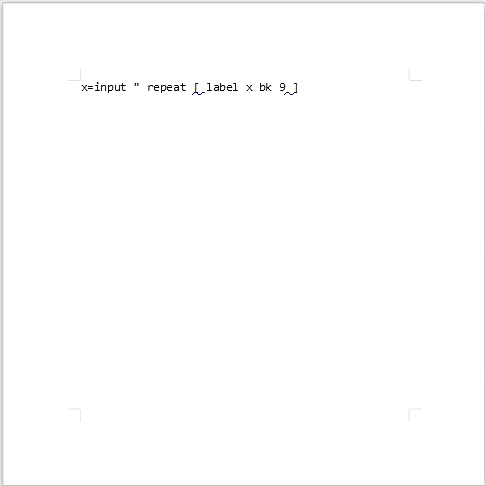Parrotプログラムを作成する
回答:
yes-newlinesを意味するわけではありませんが、入力に含まれる可能性のある改行は代わりにとして出力され\nます。質問の読み方に依存します:D
./script $'Hello\n World'実際の改行を含めるように呼び出す必要があります。TIOでは、コマンドライン引数に改行を追加できます
yes $1私のためにうまく動作します
オーム、3バイト
∞┼,
Ohmは他の言語に比べて入力処理が苦手なので、空の入力では機能しませんが、「」を入力できます。
説明
∞ Infinite loop next code (until ";" or end of line)
┼ Get first input
, Println
,[>,]++++++++++[[<]>[.>]<]か?
V、それが終了するまでnvimセッションの内部出力、それは、とSTDOUTに印刷されませんので、TIOはセッションを殺すとSTDOUTに何も見ません。私はあなたが言ったことを知りませんでしたが、残念ながらそれはVを修正しません
Ruby、18 17 12 + 2 = 14バイト
-nフラグを指定して実行します。
loop{$><<$_}
編集:-nフラグの@sethrinをありがとう!
-nフラグを使用して、スキップしgetsます。
AutoHotkey、20バイト
OPは、出力がどのように発生するかを指定せず、その後の改行で無限に発生する必要があると述べました。AHKはcmdの相互作用に合わせて調整されていません。したがって、出力ToolTipはマウス位置で繰り返し発生します。

loop
tooltip,%1%`n`n
AHKのloop機能が気に入っています。loop次のブロックを永久にloop, 10繰り返し、10回繰り返します。Pythonのような他の言語ではこの機能を見逃すことがあります。
AutoHotkeyのエスケープ文字は`(Windowsパスのバックスラッシュに問題はありません)です。何らかの理由で、末尾の改行は無視されるため、2回必要です。(trayTipこの「バグ」はないかもしれませんが、ワインで実行しているためテストできません)
古い答え:
loop
msgbox,%1%
OPがこのソリューションを好まない可能性が高いことに気付きました。出力はユーザーインタラクションで行われ、改行は含まれません。別の方法を探します。
Python 2、25バイト
s=input()
while 1:print s入力は、Pythonリテラル(文字列の引用符、角括弧、またはリスト/タプルのコンマ区切りアイテムの括弧など)であることが期待されます。
Python 3はprint関数であるため+1バイトになりますが、raw_input()Python 2の4バイトのペナルティなしで生の入力を行うこともできます。
Haskell、14バイト
cycle.(++"\n")
入力に改行を追加し、その無限コピーのリストを作成します。
代替バージョン、14バイト:
unlines.repeat
Braingolf、14 12バイト
#
V[R!&@v1+]
完全に人間のおかげで-2バイト
説明
#\nV[R!&@v1+] Implicit input of string as charcodes
#\n Push charcode of newline
V Create stack2
[R...v1+] While loop, runs endlessly
!&@ Print entire stack1 as chars without popping
Cubix、6バイト
AN/qvo
A
N / q v
o
N/ANewline(10)をプッシュし、スタックに入力しますvループにリダイレクトするo/q文字を出力し、スタックの一番下に連続的にプッシュするループ
スタックからEOI(-1)インジケーターを削除しようとしていましたが、出力に影響を与えるようには見えないため、バイトを節約しました。
Japt, 5 bytes
OpU;ß
Explanation
OpU; output the input with a newline
ß run the code again with the same input
C#, 40 bytes
s=>{for(;;)System.Console.WriteLine(s);}MATL, 4 bytes
`GDT
Explanation
` % Do...while loop
G % Grab input
D % Display it on a new line
T % Literal TRUE to create an infinite loop
C, 26 bytes
f(char*s){for(;;)puts(s);}
A function, f, that takes a C-style string as a parameter, s. The body of the function loops repeatedly, passing the string to the library function puts, which outputs the string to the standard output (stdout) along with a trailing new-line.
Pretty simple stuff. The only hack here is taking advantage of default-int for the return value and then not actually returning a value. That doesn't matter in this case, though, since the function never returns (it just keeps printing forever)!
f(char*s){puts(s);f(s);} saves a few
Java 8, 34 bytes
s->{for(;;System.out.println(s));}
Surprised there wasn't a Java answer yet.
Try it here. (Wait 60 second for it to time-out.)
Real time: 60.008 s according to the Debug-section before it outputs the result (and gives two warnings 60-sec limit exceeded and 128kb exceeded).
Pyth, 2 bytes
#
Unfortunately I can't remove Q :(
You need to run from command-line like this, so that this is competing:
python3 pyth.py -c "#
"
The interpreter has been fixed too.
><>, 16 bytes
i:0(?v
:o71.>~a{
As mentioned in the comments below my first attempt may have misunderstood the question so the newer 16 byte solution has been made, I have left the original below so people may see.
><>, 13 bytes
<ov!?+1:i
oa<
while(1){print"$ARGV[0]\n"}
